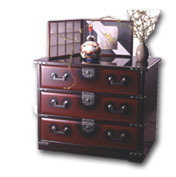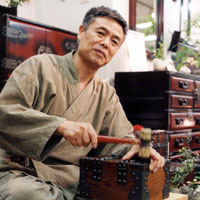

Total:131items
- Pottery & Porcelain (18)
- Lacquerware (4)
- Glasswork (2)
- Wood & Bamboo Work (19)
- Leather Work (1)
- Papermaking (13)
- Textile (20)
- Dyeing products (5)
- Masonry (1)
- Metal Work (11)
- Stationery (4)
- Livingware (3)
- Accessory (4)
- Toys & Entertainment (14)
- Interior (2)
- Other crafts (10)

 |
Main Production Site:Kagawa |
 《Characteristics》
《Characteristics》This work is made by layering Japanese paper and the astringent juice of the persimmon. The basic way of making Japanese Honshibori Ikkanbari is to paste Japanese paper and paint the persimmon juice on top of a mold. Ikkanbari has various merits and features.
1. It is light and strong. In addition to that, it remains unchanged if exposed to cold or hot water.
2. The work has a smooth feel and aesthetic quality, so people do not grow weary of it.
3. As the dirt and scratches are less conspicuous than those on other lacquer ware, it is easily used.
4. As it is waterproof, it can be cleaned with a wet cloth.
5. The use of Ikkanbari gives off a refined impression.
[A traditional craft designated by Kagawa Prefecture]
Source: Mr. Yuzo Uno (Ikkanbari-ya)
Translation: Tomoe Ukida, reviewed by Catherine Newman

| Materials | Bamboo, wood, glass, pottery, plastic, etc |
|---|---|
| Crafting Processes | (Preparing materials)
Bamboo, wood, glass, pottery, plastic, etc. ↓ (Preparing Japanese paper) Decide the quality and size depending on the material. ↓ (Pasting Japanese paper) Tear Japanese paper without using a knife, and stick it to the mold with paste containing bracken starch. ↓ (Coating with the astringent persimmon juice) Dry the material covered with the paper and paint it with the persimmon juice when it is dried enough. The temperature should be 5 to 29℃ for the work. Dry it again and give moisture to it by exposing it to the night dew. Repeat this process more than five times. ↓ (Mud dyeing) Paint it with a liquid in which stone powder is dissolved, adjust it by drying, polishing, drying again, and coloring, and apply the last coat. This process is repeated more than 20 times. |
| History | As people used to buy daily commodities at the markets in spring and autumn, they could not quickly buy new ones even if the old ones broke. A repairing method called Honshibori Ikkanbari was created in such a situation. People pasted Japanese paper on a broken basket and reinforced it by applying the persimmon juice, which was easily obtained and waterproof, in order to use it again. This is the origin of Honshibori Ikkanbari.
Due to the ordinary repairing work, people did it in their spare time without thinking about the cost or labor. This is why it is called Honshibori Ikkanbari, which means to paste (hari or bari) in an idle moment (ikkan), and is said to have over 600 years of tradition. |
| Related URL | http://ikkanbari.com/index.html |



